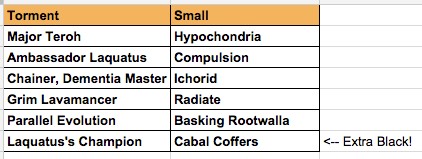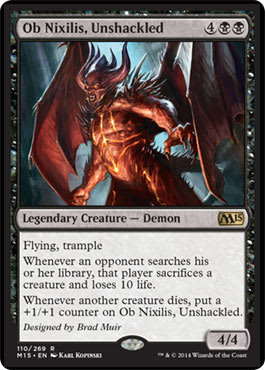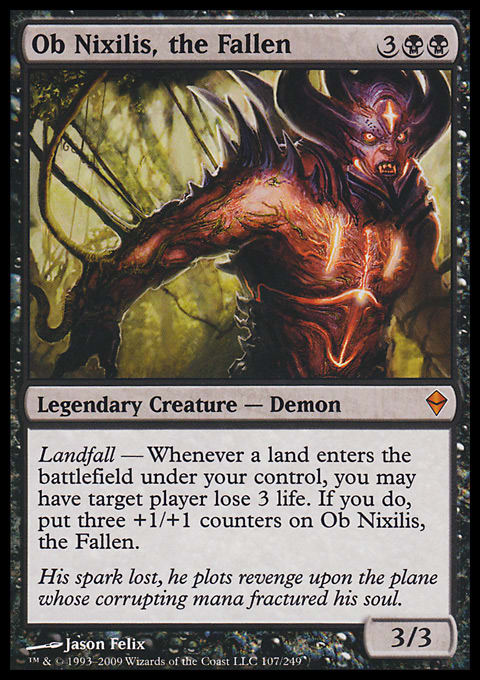Greetings, Magic players!
This week, I showcase my latest creation. Recently, I have been building a Cube, and my approach to constructing it has been rather . . . different. As of this article, I am finally finished with the list, and I thought, What better way to christen my glorious creation than to share it with the Internet? This week, we are getting our Cube on!

Original image found here
Cube Your Enthusiasm
For the longest time, I have wanted to build my own cube. Over the course of the past five years, I have lived in four different places. Each time I moved, I had to go through the process of finding a local game store that I liked and could play Magic at. With each move and each new store, I had been secretly hoping to find a group of players who would be interested in having a Cube to draft on a regular basis. Three moves came and went, and I still had not found a group interested enough in the format to justify putting in the work required in creating and maintaining a proper Cube list. My last move to my current apartment in New Jersey would change that.
As I was getting ready to make move number four to my current residence in Jersey, I was talking to one of my college friends about the fact that I would be moving close enough to him that we could get together and play Magic on a somewhat regular basis. Naturally, he was excited, and he suggested that we meet up at a college halfway between both of us where he attended a trading card game night run by his younger brother attending that school. Long story short, I went and found a large, regular group the members of which were extremely excited by the proposition of having a Cube they could draft and play. Finally having the justification I needed to build the sucker, it was time to come up with a theme.
Expressing Yourself through Cubism
Cubes come in a variety of shapes, sizes, and themes. You can build a Modern Cube and limit your list to cards legal in that format, or you can build a Legacy Cube, or even a Vintage Cube. You can introduce the Power Nine to your Cube and really ramp up the crazy. For those of you who don’t have a money tree growing out back dedicated to purchasing 2.5” by 3.5” pieces of cardstock, you can build a Pauper Cube. Gathering Magic’s fearless leader Adam Styborski has a very popular and well maintained Pauper list that he is constantly maintaining.
But you do not have to stop at just making a Cube list for a particular format. Is there a block that you really enjoyed drafting, such as Innistrad or Odyssey? Build a Cube that will mimic that format so that you can draft it forever. Did you really enjoy Conspiracy? Create a Cube that allows limitless Drafts with your friends.
Some Cube lists are really creative with their themes. Sean Main has discussed his hyper Cube, and he recently completed a flavor Cube filled with Vorthosian goodies. This particular list was inspired by the idea of creating a Draft environment in which the ten three-color charms (Bant, Esper, Grixis, Jund, Naya, Abzan, Jeskai, Sultai, Mardu, and Temur) would be first-pickable in pack three if you opened one in your colors. Have you ever wanted to try building your own Magic set based on a world of your own creation? Why not create that world in the form of a Cube? This Cube was built to create an environment that played as if you are on a world covered in dangerous deserts. Needless to say, the possibilities for creating your Cube are limited only by your own imagination.
When it came time to make my own Cube, I asked myself what my goal should be. Would I try to recreate a favored Draft environment or try to craft a powerful Modern-legal list? Should I attempt to create my own world and let my Vorthos flag fly? In thinking about what I should do, I came to the realization that Magic is over twenty years old, and in the time since its birth, the players have experiences countless blocks that touched upon numerous worlds. However, the average Magic player has been playing the game for nine years. While that is an incredible feat for any game, it means the average player missed out on over half of the overall gameplay at some point in the course of his or her time invested in the game.
This got me thinking—what if there were a Cube that tried to capture all of it? That’s right: All of it. What if there were a Cube that tried to encapsulate the entire history of Magic into a single play experience? What would that look like? Was it even feasible? In order to answer these questions, I decided to attempt to build the Magic history Cube.
Restrictions Breed . . . Cubes
In order to go about such a momentous task, I decided to start by setting some ground rules for myself in order to help ensure I was properly capturing the essence of Magic’s immense history. The following is a list of restrictions I came up with in order to help guide my process.
Rule 1: My Cube will cover every single set from Revised through the most current printed set.
 |
 |
This decision to exclude Alpha and Beta and Unlimited came from the desire to actually own a physical copy of the Cube to play with. I do not have the money to spend on original Alpha, Beta, and Unlimited cards—also, most of the cards I would want from those sets were in Revised anyway (apart from the Power Nine).
Rule 2: My Cube will include eighteen cards from each printed large set and twelve cards from each printed small set.
Due to the fact that this Cube is trying to cover all of Magic’s history, I knew that I could quickly end up with a list that was impossibly large, but I also did not want the number of cards from each set to be so small that the block’s personality would not shine through. I settled on the numbers eighteen and twelve because, when combined, each block would have roughly forty-two to forty-eight cards to try to cover what that block was about. Those numbers are also perfect for balancing the color distribution of the Cube, and it allowed me to create my next restriction.
Rule 3: For each set, the color distribution across the cards chosen should be as close to even as
possible.
For this restriction, I wanted to make sure that each player drafting a different color would be able to experience every set from Magic’s history. In order to do that, I made sure that for each set in the Cube I had an equal distribution of colors across the cards that were picked. As an example, we can look at Odyssey. Odyssey was a large set, so I would need eighteen cards from that set included in the Cube. Of those eighteen, I could include three white, three blue, three black, three red, and three green cards (fifteen total), leaving me with three empty slots. I treated those three remaining slots as wildcard slots, in which I could put artifacts, gold cards, or cards of any color. For a small set, ten of the twelve cards would be mandatory for the colors (two white, two blue, etc.) and would have 2 wildcard slots. This restriction helped not only to make card-inclusion decisions easier, but also to ensure there would be a relatively even color distribution across the entire Cube.

Rule 4: The Cube will be roughly fifty percent creatures.
This restriction was set in place in order to mimic current Magic design philosophy for creating interesting Limited environments. Magic is more fun when you are swinging across the table with creatures, and I wanted my Cube to emulate that.

Rule 5: Each instance of the main mechanics and themes for each block must be included.
I created this restriction in order to make sure that every mechanic that has been created for Magic over the years was represented—and also to make sure that the theme of the particular block was present. For example, for Return to Ravnica and Gatecrash, I made sure to have at least one card for each of the ten guild mechanics.
Rule 6: All important storyline characters must be present, and in their most current forms.
This restriction is a more just a personal one. I am a diehard Vorthos at heart, and I am a huge fan of Magic’s storyline. I wanted to make sure that the stories from Magic’s past were present within the Cube as players were drafting, so in order to do that, I made sure to include a copy of every storyline-relevant character and card for each set that he or she was introduced in. Yes, the entire crew of the Skyship Weatherlight is in my Cube, and no, I do not regret the decision. The second part of this rule lies in the idea that I will only include characters in their current forms. One thing that I do not like about how legendary creatures are currently handled in the game is that the following situation is possible on your side of the board:
Because of the way the legend rule works, and the fact that Planeswalkers are a different type than creatures, it is actually possible to control all three versions of Ob Nixilis at the exact same time. In order to combat this, I only included the most recent version of each character in the Cube. In Ob Nixilis’s case, that would mean that The Unshackled version is in, while the other two versions are out.
Rule 7: Vorthos can break any rule.
And we come to the final restriction I imposed on myself when creating the Cube. It was a requirement for me that the Cube needed to jive with my inner Vorthos. How did I do that? I did so by making sure that the story of each block came through in the cards that were selected. I often found that in order to ensure the story came through for each set, I needed to break some of my other rules above. I decided that it would be okay to deviate from my restrictions as long as it was justifiable through the flavor of the block in question.
For example, Torment was the “black set,” and it focused on the fact that the color pie was lopsided toward black as Nightmares reigned supreme over Otaria. In order to showcase that, I used the two wildcard slots for extra black cards, breaking my even-color-distribution rule:

Alara had a shard theme, so instead of splitting my picks in to the five colors, I split them across the five shards breaking the three-cards-of-each-main-color rule:

Mirrodin Besieged was all about the Mirran–Phyrexian war. For that set, I balanced my picks fifty-fifty between the two factions:

Ant’s Magic History Cube
In the end, I came to the final list linked below, containing equal distributions of cards from Revised through Khans of Tarkir.
This Cube is larger than your average Cube, and it clocks in at a whopping 1,272 individual cards. Now, while there are some cons to having such a large Cube—such as storage and transportation and shuffling—there are also some extra benefits. This Cube offers a ton of variety. If you shuffled up this Cube one time, eight players could draft three times in a row and not have to see the same card twice. Three times! Also, this Cube offers another extremely interesting format that most Cubes cannot handle: Sealed Commander.
With this Cube, four players are able to open fifteen booster packs each, giving them 225 cards each to build Commander decks from. To showcase this ability, I constructed a Sealed Commander deck from my Cube. Opening fifteen booster packs gave me the following card pool:


Looking at this pool, I decided to go with all-out Mardu, and I built a R/W/B Commander deck around the Orc khan himself Zurgo Helmsmasher. Also as a house rule, my playgroup decided that when we do Sealed Commander, we need to come up with witty decklist names—you know, because reasons.
Creatures Raid Everything Around Me CREAM! ? MTG History Cube Sealed Commander | Ant Tessitore
- Commander (0)
- Creatures (38)
- 1 Anger
- 1 Bane of the Living
- 1 Cadaverous Knight
- 1 Capashen Knight
- 1 Dark Hatchling
- 1 Dauthi Trapper
- 1 Deathgaze Cockatrice
- 1 Exalted Angel
- 1 Grim Lavamancer
- 1 Hand of Honor
- 1 Hopeful Eidolon
- 1 Northern Paladin
- 1 Nyx-Fleece Ram
- 1 Obsidian Fireheart
- 1 Paladin en-Vec
- 1 Ruthless Ripper
- 1 Shivan Dragon
- 1 Shriekmaw
- 1 Skinrender
- 1 Skyknight Legionnaire
- 1 Slumbering Dragon
- 1 Southern Paladin
- 1 Underworld Cerberus
- 1 Vampire Hexmage
- 1 Viashino Shanktail
- 1 Beast of Burden
- 1 Masticore
- 1 Cabal Patriarch
- 1 Chainer, Dementia Master
- 1 King Macar, the Gold-Cursed
- 1 Kozilek, Butcher of Truth
- 1 Oros, the Avenger
- 1 Purphoros, God of the Forge
- 1 Tahngarth, Talruum Hero
- 1 Tajic, Blade of the Legion
- 1 Tivadar of Thorn
- 1 Urabrask the Hidden
- 1 Vish Kal, Blood Arbiter
- Planeswalkers (1)
- 1 Ajani Steadfast
- Spells (21)
- 1 Divine Verdict
- 1 Faith's Reward
- 1 Pyrokinesis
- 1 Apocalypse
- 1 Decree of Pain
- 1 Flicker
- 1 Incendiary Command
- 1 Merciless Eviction
- 1 Pillage
- 1 Reign of the Pit
- 1 Sign in Blood
- 1 Bedlam
- 1 Invasion Plans
- 1 Ivory Mask
- 1 Righteous War
- 1 Argentum Armor
- 1 Armageddon Clock
- 1 Chromatic Lantern
- 1 Coalition Relic
- 1 Coat of Arms
- 1 Sai of the Shinobi
- Lands (38)
- 12 Mountain
- 12 Plains
- 12 Swamp
- 1 Gargoyle Castle
- 1 Rath's Edge
I hope you enjoyed this look into my Cube. If you are interested, head over to my CubeTutor link, and try drafting it for yourself. Try building a Sealed Commander deck; heck, try drafting one. Let me know what you think in the comments below—or if there were any cards you think I might have missed along the way. Do you have a Cube list you would like to share? Send me a link to your list.
Have fun, and start cubing!
-Ant

























